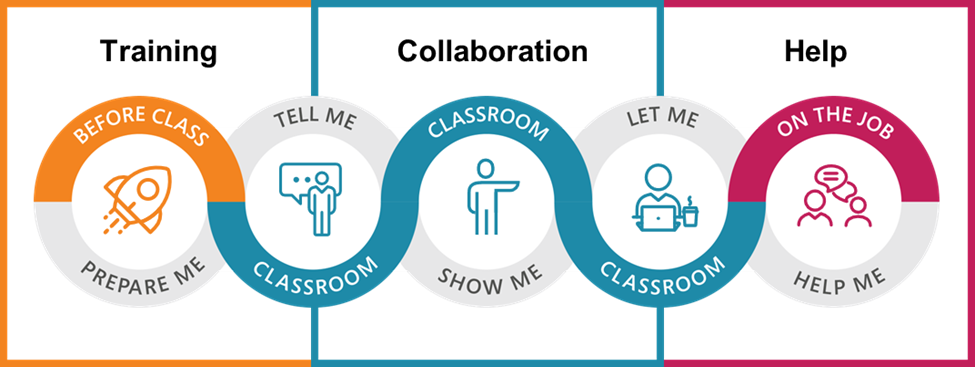Many of my GP Strategies colleagues approach the subject of sustained behavior change from different perspectives. Some of my peers are “tech gurus,” conversant on all the latest tools and techniques that could be used to drive behavior changes. Others are experts in neuroscience and would ideate solutions based on how the adult brain works.
Me? I’ve spent my career in the space of enterprise technology adoption as an informally-trained instructional designer. I’ve learned on the job from some of the best over the years. Most of my experience centers around designing, developing, and deploying learning programs that support complex workplace digital transformations, and there are a few keys for enabling your people to create sustained behavior changes during a technology implementation.
Design and Deploy Technology Adoption Solutions that Modify Behavior and Habits
When it comes to learning design, I use the Adult Learning Model for successful user adoption. I was first taught this model when I began my career with GP Strategies, and while we’ve updated the tools we use to create and deploy content, the theory behind this model has withstood the test of time.
The Adult Learning Model

The Adult Learning Model posits that adults learn best when they:
- Understand the organization’s goals and are prepared for the change.
- Are presented information on new business processes and systems.
- Are shown how to perform their specific job tasks in the system.
- Have an opportunity to practice in a safe but realistic environment.
- Know how to look up support information back on the job.
Technology Change Management
This learning model becomes critical when pursuing digital transformations. To sustain new workplace behaviors, alignment with a comprehensive set of technology change management (TCM) activities is critical, and TCM becomes more important as the diversity of an end-user population increases.
With so many different generations and type of learners in the workforce, TCM isn’t a one-size-fits-all activity. As the number of unique end-user groups rises, leaders must be equipped to confidently use a broad suite of tools that promote engagement.
Knowledge Transfer Techniques
A solution that drives sustainable change must also include multiple knowledge transfer techniques to prepare users to be productive and readily support themselves on the job. The five techniques within the Adult Learning Model are:
- Prepare Me: Allow for adequate time to think through and talk about what is changing; allow the learner to mentally prepare before plunging into learning new things.
- Tell Me: Give context for why learners need to behave differently.
- Show Me: Demonstrate the correct approach before asking learners to do it.
- Let Me: Make time for learners to have hands-on but realistic practice for the changes you are asking for.
- Help Me: Provide learners with access to useful reference content and other resources for when they experience moments of learning need on the job.
Other Drivers of Success for Sustained Behavior Change
Besides the learning design elements discussed above, there are other external ways we can sustain desired behavior changes, from both an organizational level and an individual one.
Organizational Drivers
- Support from a cohort of other learner communities: Create spaces that allow learners to engage with each other, ask questions, and learn together.
- Access to super users: Open lines of communication with users who are already using the system as intended and make them available for questions and feedback.
- Recognition and acknowledgment from managers and senior leaders: Encourage managers and senior leaders to recognize and uplift those that are engaging in the change and adopting the new processes and behaviors as intended.
- Tangible reward programs for achievements: An rewards program of some kind can go a long way towards encouraging employees to engage in the change.
Individual Drivers
- Feeling accountable to others: When employees feel like they play a crucial role in the success of the group, they are more likely to participate.
- Taking pride in the ability to do things differently: Seeing positive results will drive many people to sustain a new behavior. This also goes hand in hand with getting recognition and acknowledgment from managers and senior leadership.
- Transparency: Make sure that users have clear communication from leaders on how the change is progressing at large so people feel in the loop.
- Fear: Healthy fear can drive users to make behavior changes if they feel like they might be left behind or that they will be unable to complete their day-to-day tasks.
Sustainable Behaviors Drive Sustainable Change
Whatever behavior or process you are trying to change, the strategies in place must be tailored to how your people will best learn, not created to support the training or behavior itself.
To learn more about sustainable change management for your next technology implementation, check out our user adoption solutions.

